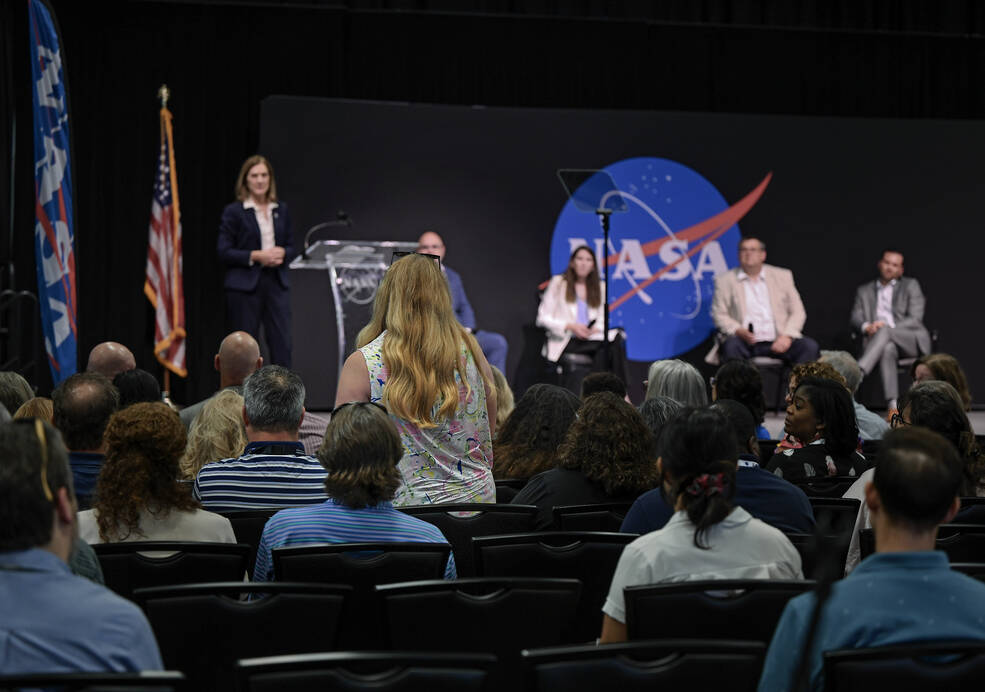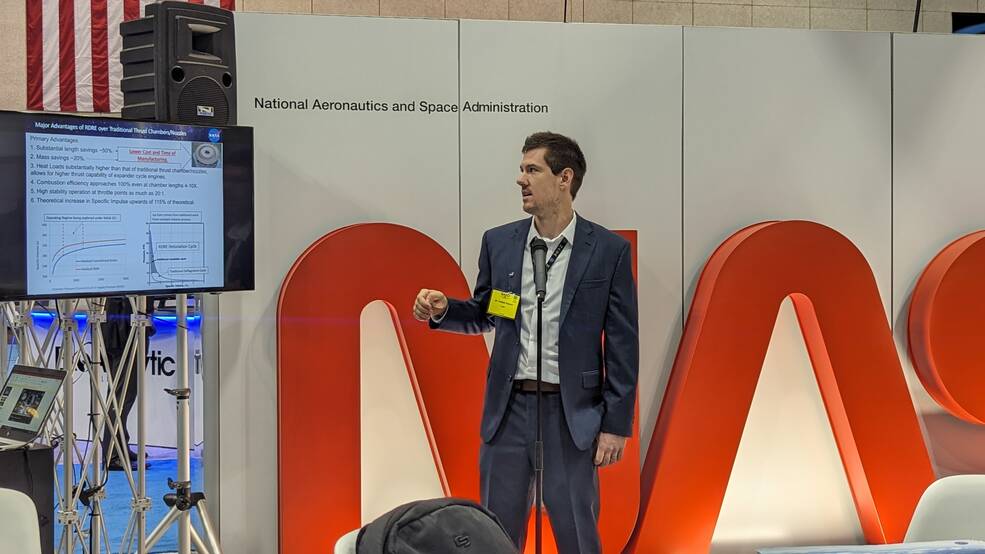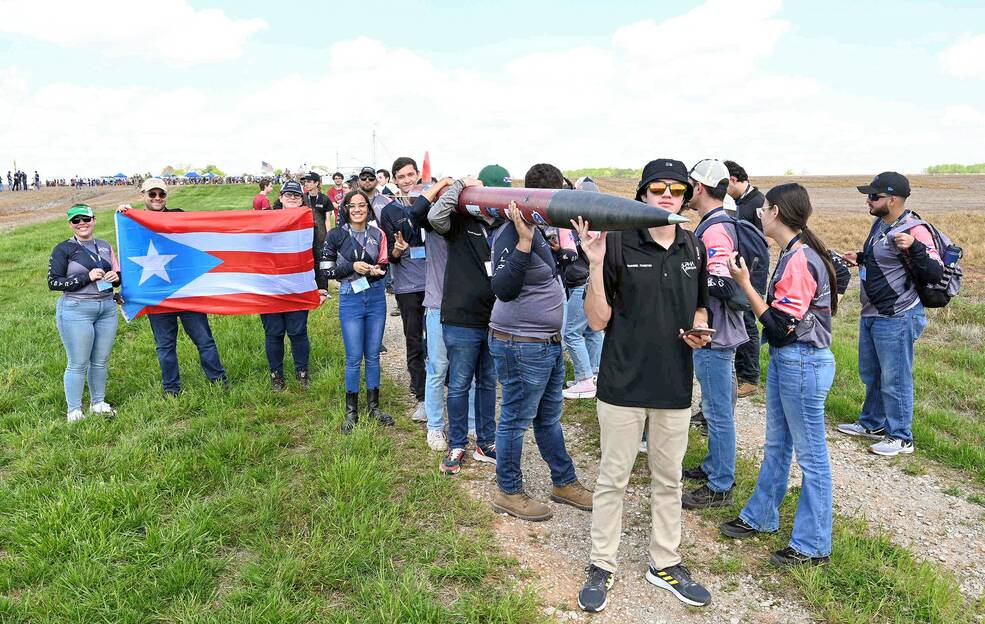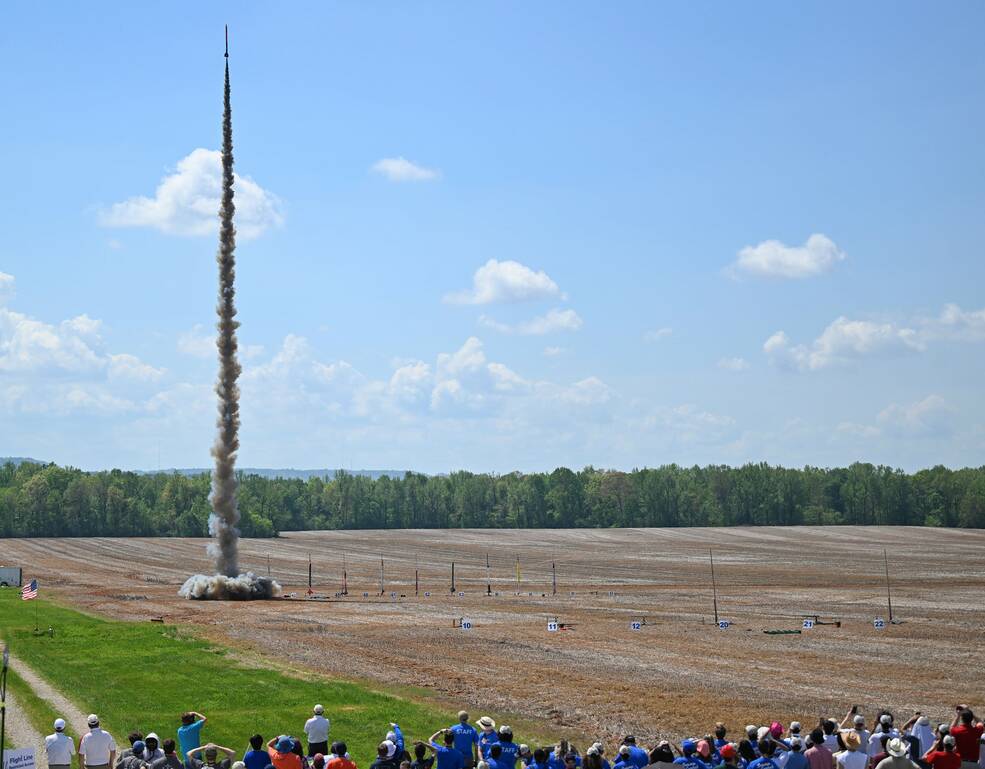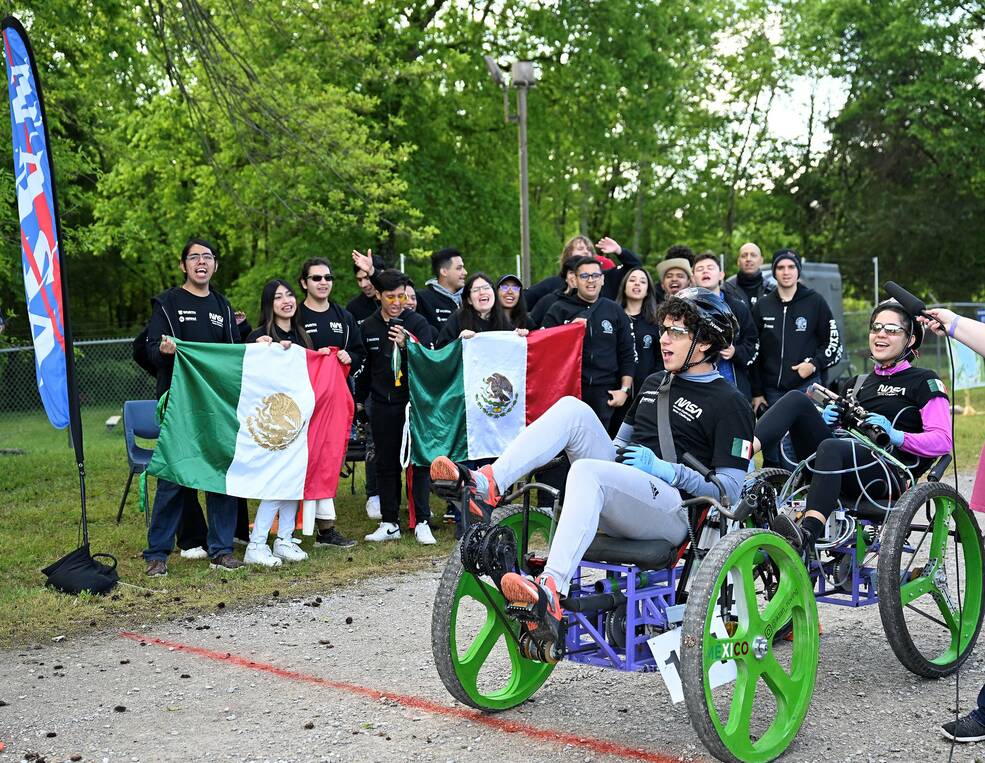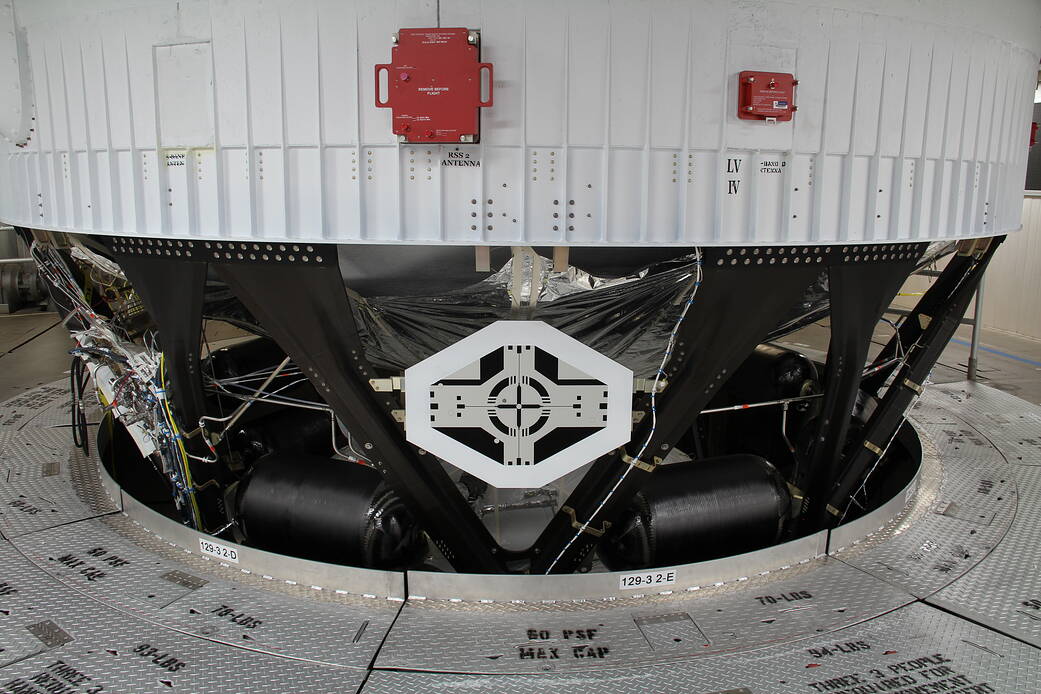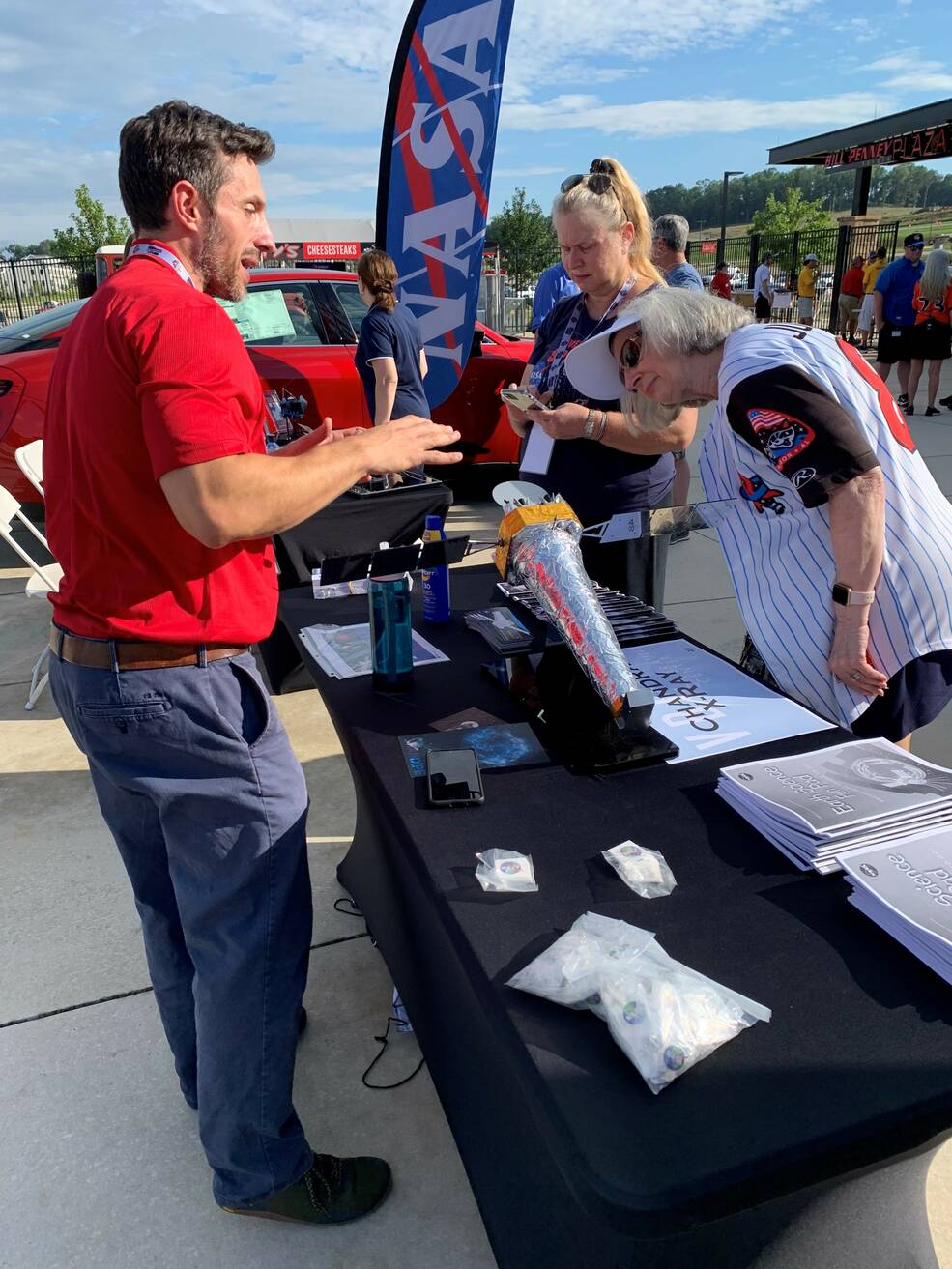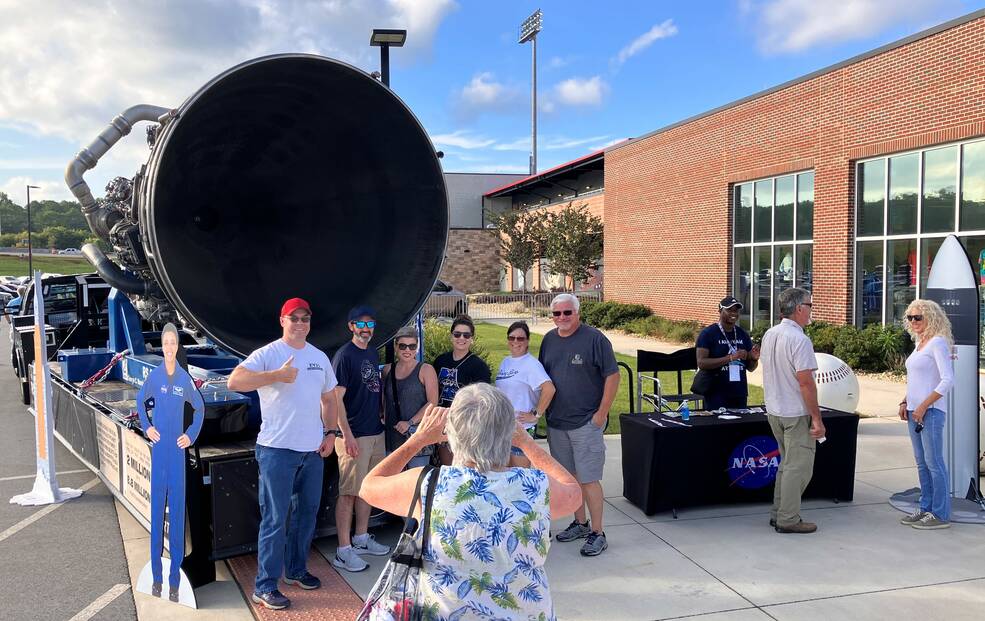The Marshall Star for August 16, 2023.
In This Week’s Star
Center Leadership Discusses Future Strategy, Culture During All-Hands
By Wayne Smith
NASA Marshall Space Flight Center leaders discussed the center’s future strategy, culture, and on-site work during an all-hands meeting on Aug. 15. The hybrid meeting at Activities Building 4316 was the first all-hands since Jody Singer announced her retirement as center director last month.
Acting Center Director Joseph Pelfrey opened the event by welcoming team members and discussing the leadership transition. Pelfrey said he will work with the center’s leadership team to make the best decisions for Marshall and the agency.
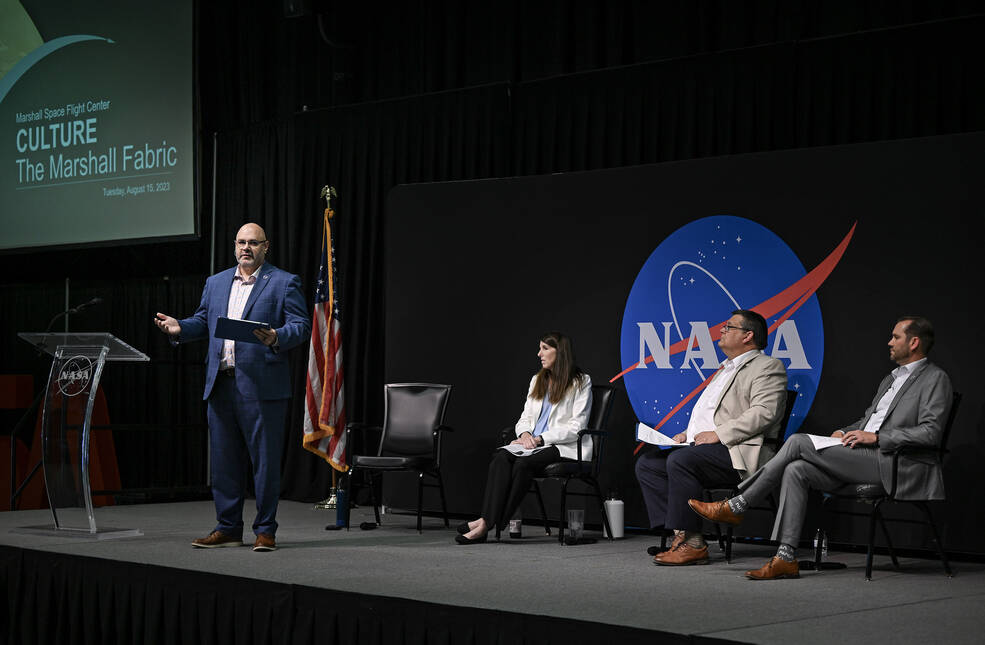
“I’m committed to serving you and serving the center to make sure we have a vibrant future,” Pelfrey said. “I do have a few priorities during this transition period, all of which are things that we have been doing for some time. First is continuing to deliver on our commitments, capture new mission assignments, and new partnerships.”
Pelfrey said the center’s pursuit of new business opportunities “will ensure we have a bright future.”
Marshall Associate Directors Larry Leopard and Rae Ann Meyer, along with Center Strategy Lead Jeramie Broadway, joined Pelfrey on stage for the meeting. In addition to future strategy, they also provided updates on a wide range of other topics, including NASA’s budget process, growing Marshall’s vibrant culture through quality on-site events, and results from the most recent Federal Employee Viewpoint Survey. SLS (Space Launch System) Program Manager John Honeycutt spoke about Marshall’s continued, vital role managing the SLS Program.
Aug. 15 marked the first day of the new expectation for employees to work onsite at least three days a week following the Biden-Harris Administration’s decision to end the COVID-19 public health emergency. Common core days are Monday and Thursday, with supervisors working with team members on the optimal on-site days to meet the needs of “mission, team, and individual,” said Pelfrey.
“There is flexibility in these expectations, but they are expectations,” Pelfrey said.
Leopard and Broadway provided updates on Marshall’s center strategy, calling it a “pursuit culture.” The strategy breaks down Marshall’s role into nine business units, with pursuits under each unit. The business units include habitation systems, advanced space transportation systems, lander systems, SLS, surface and technology systems, in-space and surface missions operations, science, U.S. government, and industry.
“The agency is looking for the centers to say, ‘this is where our skills and capabilities are, we’ve been honing this capability, and we can do this particular job for you,’” Leopard said.
Broadway said Marshall is seeing results from the center strategy with proposals, increased partnerships, and new assignments. He explained that “all of this is a group effort,” to further develop the strategy, with collaboration between the center’s workforce, leadership, commercial partners, stakeholders, and the agency’s headquarters, toward a common goal. “When we say it’s your center strategy, everyone fits in.”
Following the success of the Artemis I mission in November, Honeycutt discussed preparing for upcoming SLS Artemis II and III missions, as well as telling team members more about EPOC (Exploration Production and Operations Contract) for future Artemis missions. “I think, based on where the center is headed, we’re still going to have a lot of great meaningful work to do here at the center over the long haul, and I’m going to need the technical skills and expertise to do the work we need to do,” Honeycutt said.
Meyer talked about Marshall’s culture and noted two upcoming on-site events – a Sept. 21 retirement celebration honoring Singer and fall family barbecue Oct. 19. She also shared initial findings from the Federal Employee Viewpoint Survey.
Talking before a question and answer session closed the meeting, Meyer also pointed to mission, team, and individual needs when discussing on-site work, and the center’s pursuit culture.
“Coming out of COVID, almost a quarter of our civil servant workforce had never been onsite,” Meyer said. “Since the beginning of the calendar year, we’ve rolled out a new center strategy calling for a pursuit culture as well as setting expectations for a hybrid work environment. There’s an intersection of these two changes that we need you to see yourself in, and that’s the experience that you have, and the impact you have on our culture.”
Smith, a Media Fusion employee and the Marshall Star editor, supports Marshall’s Office of Strategic Analysis & Communications.
Marshall Team Talks Rockets, Technology, and More at SMD Symposium
By Jessica Barnett
It likely came as no surprise to attendees at the Space and Missile Defense Symposium that NASA’s Marshall Space Flight Center would have not one, but two booths for attendees to explore.
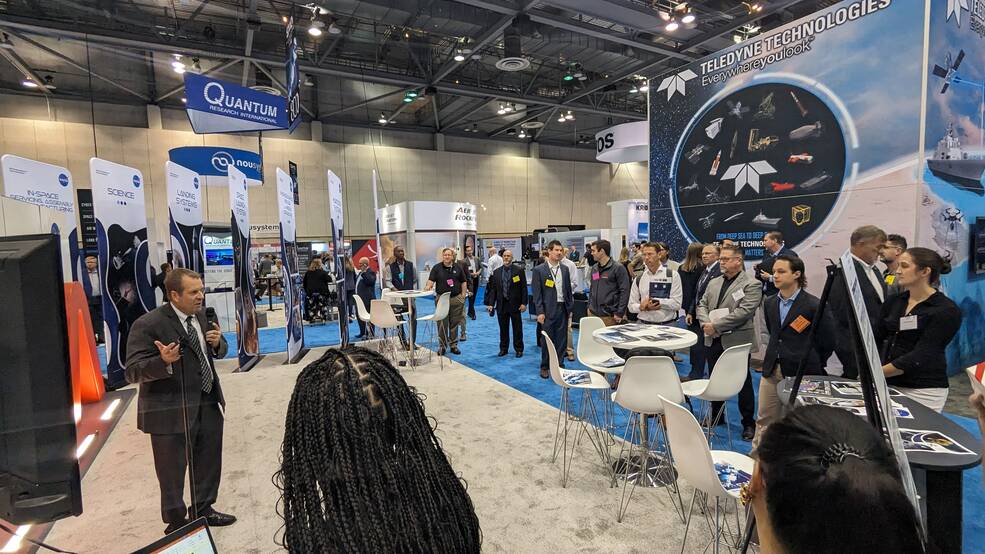
The three-day event took place Aug. 8-10 at the Von Braun Center downtown in Huntsville, Alabama, and Marshall team members made sure the center was well-represented. The annual symposium brings together top government and industry leaders in space and missile defense.
“SMD Symposium was a great experience,” said Marshall Associate Director Larry Leopard. “We got to hear from Department of Defense agencies that work in the space domain and compare notes on the goals and challenges facing our industry as we all move deeper and deeper into space.”
Those who visited Marshall’s booth in the VBC East Hall were invited to learn about the center’s test laboratory and some of the many lessons learned through its specialized capabilities. In the VBC’s South Hall, attendees were treated to a series of 10-minute presentations on a wide variety of topics, from hypersonics and multi-body dynamics to space nuclear propulsion and Mars habitats.
Thomas Teasley, a liquid propulsion systems development and test engineer at Marshall, discussed the Rotating Detonation Rocket Engine, a compact liquid rocket engine that uses detonation for quicker combustion and increased efficiency. Teasley said it was his first time attending or speaking at the symposium, but he was pleased with how many people showed up to hear about the engine. Early estimates show an average of 400 people a day stopped to hear Marshall team members speak.
“Every time I looked up, I could see eyes wide open, very interested in the subject,” Teasley said. “The technology is so young that not a lot of people know about it. There’s a lot of key players in the industry that are very interested in the technology for lander-ended systems, for in-space applications, but a lot of people in the defense industry don’t really know about it yet.”
Attendees from all over the country stopped at the Marshall booth to check out the large banners, take a selfie with the NASA worm logo, and learn more about the NASA center’s plans to take cargo and astronauts to the Moon and beyond.
Barnett, a Media Fusion employee, supports Marshall’s Office of Strategic Analysis & Communications.
Global Collaboration Leads to New Discoveries in Lightning Research
By Liz Junod
A group of researchers from the University of Bergen (Norway), NRL (U.S. Naval Research Laboratory), and three NASA centers have just completed a month of flights to study lightning and the vast energy fields around thunderclouds in our atmosphere. Their new observations will help scientists gain further insight into how lightning forms and help them better predict when storms could turn severe.
With operations based out of Tampa, Florida, the ALOFT field campaign logged approximately 60 hours of flight time across Central America and the Caribbean. The team used NASA Armstrong’s ER-2 aircraft to fly near thunderclouds as tall as 10 miles in altitude to measure gamma-ray glows and flashes produced by the electric fields of thunderclouds. ALOFT is short for Airborne Lightning Observatory for Fly’s Eye GLM Simulator and Terrestrial gamma-ray flashes. The campaign included researchers and flight crews from the University of Bergen, NRL, NASA’s Armstrong Flight Research Center, NASA’s Marshall Space Flight Center, and NASA’s Goddard Space Flight Center.
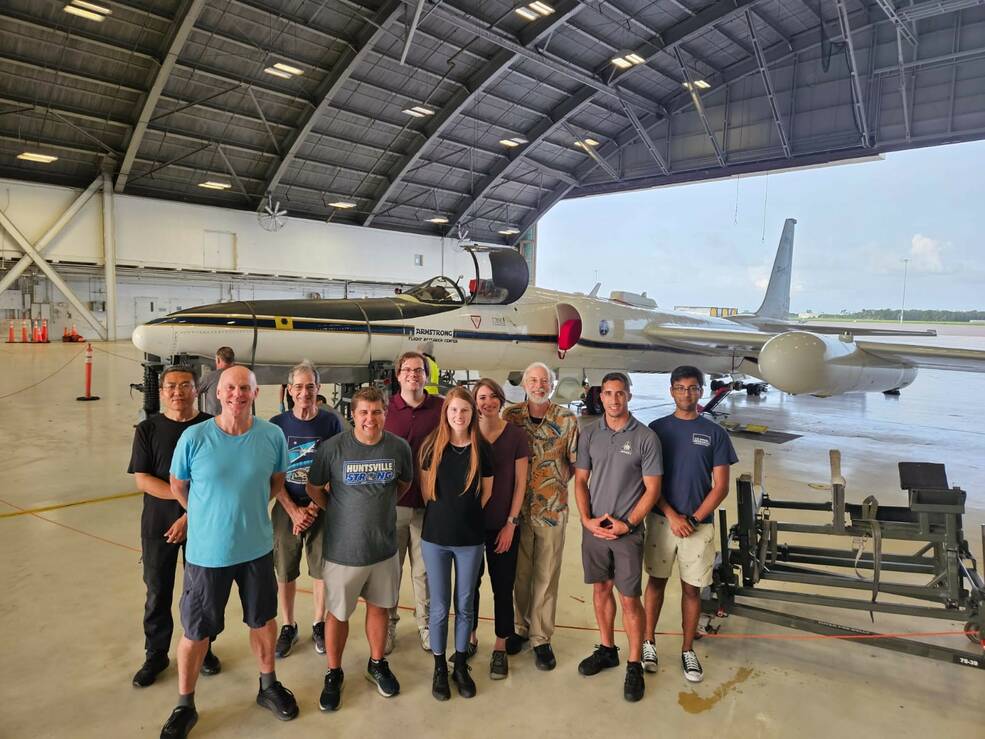
Led by Nikolai Ostgaard of the University of Bergen and using new and recently upgraded lightning instrumentation, the team captured the most detailed airborne analysis of gamma-rays and thunderclouds ever recorded. One of the reasons for the success was the University of Bergen-Bismuth-Germanium-Oxide gamma-ray detector instruments, which collected and downloaded real-time data, allowing researchers to instruct the ER-2 pilot to return to a glowing thunder cell if it continued to glow.
“Within a thunderstorm, there’s a huge electric field that can cover a large area within the thundercloud,” said Ostgaard, who has been studying gamma-ray flashes and the electric fields within thunderclouds since 2005. “Once the electric field accelerates free electrons, they produce the gamma-ray radiation, which creates a glow throughout the entire thunderstorm.”
There are two types of gamma-ray radiation emitted from thunderstorms: gamma-ray glows and terrestrial gamma-ray flashes. The glow can last from hours to minutes, so the team is working to determine how long these glows last on average. They also are investigating if there’s a relationship with the terrestrial gamma ray flashes, which are very short bursts of gamma rays that occur from specific points within the thundercloud.
Teams from Marshall and Goddard also added instrumentation to the ER-2 aircraft to observe other wavelengths emitted by thunderclouds. For instance, Timothy Lang and Mason Quick of Marshall, with support from the University of Alabama Huntsville and partners, flew their FEGS (Fly’s Eye GLM Simulator), which has been substantially upgraded since it was last flown in 2017.
“FEGS optical sensors capture different wavelengths, such as near infrared and ultraviolet radiation from lightning, that are not captured by current satellites,” Lang said. “These smaller, less dense flashes are known as precursors of when storms are turning severe. FEGS could help scientists see when storms are strengthening and provide extra lead time of information to keep the public safe from the threat of lightning.”
The partnership with the University of Bergen was also beneficial for future NASA missions, Lang said. “We were able to add some additional instruments that can help with forthcoming missions and could help NASA build the next generation of lightning instrumentation.”
NASA has been developing cutting-edge lightning instrumentation for decades. In the 1980s, a Marshall team including Hugh Christian, Richard Blakeslee, and Steve Goodman developed one of the earliest space sensors for optical lightning detection. Later, teams led by Marshall and the University of Alabama in Huntsville built the Optical Transient Detector, which was active from 1995 to 2000, and the LIS (Lightning Imaging Sensor), which was flown on the Tropical Rainfall Measuring Mission from 1997 to 2015. A second LIS was launched to the International Space Station in 2017 and remains active. The Marshall team also contributed to the commercially built Geostationary Lightning Mapper aboard the National Oceanic and Atmospheric Administration’s Geostationary Operational Environmental Satellite series.
Junod is a communication specialist supporting NASA SPoRT.
NASA Accepting Proposals for 2024 Student Launch Challenge
The 24th year of NASA’s Student Launch challenge has officially begun with the release of the 2024 handbook, providing in-depth guidance on submitting proposals, safety information, competition rules, and more. Interested teams should view the website and handbook for eligibility requirements and instructions on submitting proposals by 8 a.m. CDT on Sept. 11.
Student Launch is an annual competition which challenges middle school, high school, and college students to design, build, test, and launch a high-powered amateur rocket with a scientific or engineering payload. After a team is selected, they must meet documentation milestones and undergo detailed reviews throughout the school year.
The 2024 on-site event is scheduled for April 10-14, 2024, with final launches April 13 at Bragg Farms in Toney, Alabama, minutes north of NASA’s Marshall Space Flight Center.
“Student teams must meet similar standards used by professionals at NASA and throughout the aerospace industry,” said Fred Kepner, education program specialist and Student Launch activity lead at Marshall. “This competition is a fantastic way for students to advance their skills but is also beneficial for NASA as it enriches the future workforce.”
Each year, NASA updates the payload challenge to reflect current scientific and exploration missions. For the 2024 season, the payload challenge takes inspiration from the Artemis missions, which seek to land the first women and first person of color on the Moon for the first time since the Apollo program. Selected teams must design a SAIL (STEMnauts Atmosphere Independent Lander) payload for deployment mid-air, then safely land a group of four STEMnauts, non-living objects representing astronauts, to a predetermined location and orientation. Students will choose metrics to support evidence of a survivable landing.
“NASA has announced the four astronauts selected for the Artemis II mission and we are excited about the timeliness of this challenge,” Kepner said. “Giving students the opportunity to design individual landers will provide them with valuable knowledge which can be applied to their future careers in the aerospace industry.”
The college/university division teams must design a payload to match the 2024 requirements. However, middle and high school teams may choose to attempt the SAIL payload challenge or develop their own science or engineering payload experiment.
In addition to designing a high-powered rocket and unique payload, teams must also predict their rocket’s target altitude months in advance of launch day. The teams closest to their projection in each division win the Altitude Award, one of several awards available. Teams earn points for progress and successes achieved throughout the year and will be scored accordingly in nearly a dozen other categories, including safety review, vehicle design, social media presence, and more.
Marshall’s Office of STEM Engagement hosts Student Launch to encourage students to pursue degrees and careers in STEM (science, technology, engineering, and math) by providing them with real-world experiences. Student Launch is one of NASA’s eight Artemis Student Challenges – a variety of activities that expose students to the knowledge and technology required to achieve the goals of Artemis.
In addition to the NASA Office of STEM Engagement’s Next Gen STEM project, NASA Space Operations Mission Directorate, Northrup Grumman, National Space Club Huntsville, American Institute of Aeronautics and Astronautics, National Association of Rocketry, Relativity Space and Bastion Technologies provide funding and leadership for the competition.
NASA Seeks Student Ideas for 2024 Human Exploration Rover Challenge
Students interested in designing, developing, building, and testing rovers for Moon and Mars exploration are invited to submit their proposals to NASA through Sept. 21.
The complete details on how to participate in NASA’s Human Exploration Rover Challenge are available online. To learn more, challenge experts are hosting two webinars at 9 a.m. CDT, and again at 5 p.m., on Aug. 24. The virtual sessions will outline the proposal processes, and requires pre-registration.
“Our Human Exploration Rover Challenge will focus on an immersive story based on proposed NASA-use cases for crewed and uncrewed rovers during upcoming Artemis missions, including exploring permanently shadowed regions, positioning to recharge batteries, power and data exchange with other surface assets, and storing collected samples,” said Vemitra Alexander, challenge activity lead for NASA’s Office of STEM Engagement. “Students must determine why an autonomous rover exploring the shadowed regions has gone out of contact and, if possible, attempt to repair the robotic rover.”
By participating in this challenge, NASA hopes students will develop a deeper understanding of content and enhance their communication, collaboration, inquiry, problem-solving, and flexibility skills that will benefit them throughout their academic and professional lives. Interested teams should review the handbook for proposal guidelines and new task challenges.
In October, NASA will announce which teams are invited to the U.S. Space & Rocket Center, near NASA’s Marshall Space Flight Center, in April 2024 to showcase their submissions. Celebrating its 30th anniversary, the Human Exploration Rover Challenge tasks high school, college, and university students from around the world to design, build, and test lightweight, human-powered rovers on an obstacle course simulating lunar and Martian terrain, all while completing mission-focused science tasks. Once selected, students are required to complete months of design and safety reviews mirroring the engineering design process used by NASA engineers and scientists.
This challenge provides students a chance to engage with NASA’s Artemis program, which includes putting the first woman and first person of color on the Moon. NASA and event sponsors continue to encourage students to push the limits of innovation. The challenge is managed by NASA’s Southeast Regional Office of STEM Engagement at Marshall and is one of eight Artemis Student Challenges. NASA’s Office of STEM Engagement uses challenges and competitions to further the agency’s goal of encouraging students to pursue degrees and careers in science, technology, engineering, and mathematics.
Technicians Add ‘Target’ to NASA Artemis II Rocket Hardware
A critical auxiliary target for NASA’s Artemis II mission is ready for flight following testing at ULA’s (United Launch Alliance) Florida facility. Teams with the company added the target onto the in-space propulsion stage for NASA’s SLS (Space Launch System) rocket at ULA’s Delta Operations Center at Cape Canaveral Space Force Station on May 16. Following the safe separation of NASA’s Orion spacecraft from the rocket’s upper stage, the four astronauts aboard Orion will use the target affixed to the in-space stage for a proximity operations demonstration to test Orion’s piloting qualities. The recently installed target underwent illumination testing in May to ensure the target will be visible in the different lighting conditions of space.
The SLS rocket delivers propulsion in phases to send the Artemis missions to the Moon. Its ICPS (interim cryogenic propulsion stage) and its single RL10 engine fires twice during the Artemis II mission to put the Orion spacecraft and astronauts into a high-Earth orbit, where they will then check out Orion’s manual handling qualities using the ICPS and its auxiliary target before then heading to the Moon. During the demonstration, astronauts will use the two-foot target to test navigation and other critical Orion systems to assess its ability to approach and fly alongside another large spacecraft in space before future Artemis missions that require docking capabilities. NASA is working to land the first woman and first person of color on the Moon under Artemis. SLS is part of NASA’s backbone for deep space exploration, along with the Orion spacecraft, advanced spacesuits and rovers, the Gateway in orbit around the Moon, and commercial human landing systems. SLS is the only rocket that can send Orion, astronauts, and supplies to the Moon in a single mission. (ULA)
Marshall Team Supports Space Night with Rocket City Trash Pandas
NASA Marshall Space Flight Center research astrophysicist Stephen Bongiorno, left, discusses the 25th anniversary of NASA’s Chandra X-ray Observatory with fans during Space Night with the Rocket City Trash Pandas, Huntsville’s minor league baseball team, Aug. 8. More than 2,000 people enjoyed NASA exhibits and outreach provided by Marshall team members from the Planetary Missions Program Office; Technology Demonstration Missions; Human Landing System; Space Launch System; and the Science Research and Projects Division. (NASA/Gary Jedlovec)
Fans pose for photos in front of an RS-25 engine exhibit during Space Night with the Rocket City Trash Pandas. This test engine is similar to ones used on the SLS (Space Launch System) rocket for NASA’s Artemis missions, which seeks to land the first women and first person of color on the Moon. (NASA/Christopher Blair)
Webb Reveals Colors of Earendel, Most Distant Star Ever Detected
NASA’s James Webb Space Telescope has followed up on observations by the Hubble Space Telescope of the farthest star ever detected in the very distant universe, within the first billion years after the big bang. Webb’s NIRCam (Near-Infrared Camera) instrument reveals the star to be a massive B-type star more than twice as hot as our Sun, and about a million times more luminous.
The star, which the research team has dubbed Earendel, is located in the Sunrise Arc galaxy and is detectable only due to the combined power of human technology and nature via an effect called gravitational lensing. Both Hubble and Webb were able to detect Earendel due to its lucky alignment behind a wrinkle in space-time created by the massive galaxy cluster WHL0137-08. The galaxy cluster, located between us and Earendel, is so massive that it warps the fabric of space itself, which produces a magnifying effect, allowing astronomers to look through the cluster like a magnifying glass.
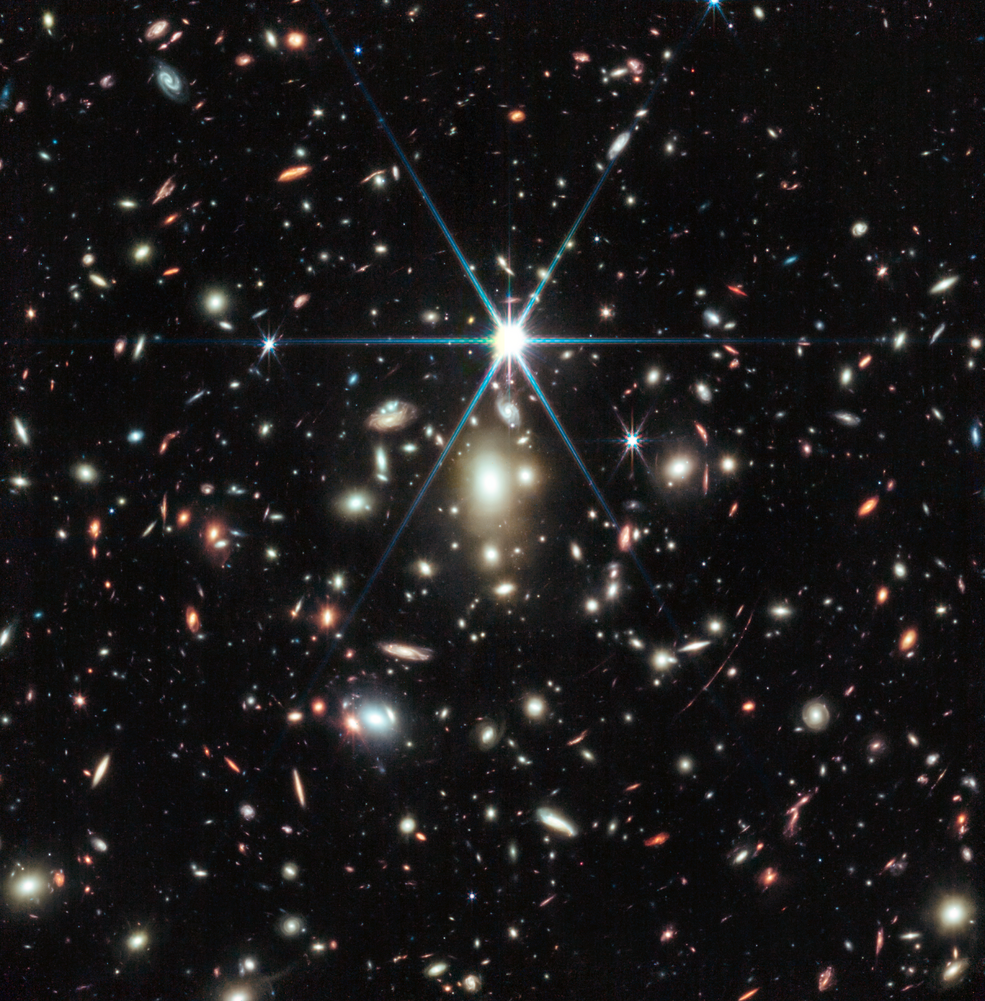
While other features in the galaxy appear multiple times due to the gravitational lensing, Earendel only appears as a single point of light even in Webb’s high-resolution infrared imaging. Based on this, astronomers determine the object is magnified by a factor of at least 4,000, and thus is extremely small – the most distant star ever detected, observed 1 billion years after the big bang. The previous record-holder for the most distant star was detected by Hubble and observed around 4 billion years after the big bang. Another research team using Webb recently identified a gravitationally lensed star they nicknamed Quyllur, a red giant star observed 3 billion years after the big bang.
Stars as massive as Earendel often have companions. Astronomers did not expect Webb to reveal any companions of Earendel since they would be so close together and indistinguishable on the sky. However, based solely on the colors of Earendel, astronomers think they see hints of a cooler, redder companion star. This light has been stretched by the expansion of the universe to wavelengths longer than Hubble’s instruments can detect, and so was only detectable with Webb.
Webb’s NIRCam also shows other notable details in the Sunrise Arc, which is the most highly magnified galaxy yet detected in the universe’s first billion years. Features include both young star-forming regions and older established star clusters as small as 10 light-years across. On either side of the wrinkle of maximum magnification, which runs right through Earendel, these features are mirrored by the distortion of the gravitational lens. The region forming stars appears elongated, and is estimated to be less than 5 million years old. Smaller dots on either side of Earendel are two images of one older, more established star cluster, estimated to be at least 10 million years old. Astronomers determined this star cluster is gravitationally bound and likely to persist until the present day. This shows us how the globular clusters in our own Milky Way might have looked when they formed 13 billion years ago.
Astronomers are currently analyzing data from Webb’s NIRSpec (Near-Infrared Spectrograph) instrument observations of the Sunrise Arc galaxy and Earendel, which will provide precise composition and distance measurements for the galaxy.
Since Hubble’s discovery of Earendel, Webb has detected other very distant stars using this technique, though none quite as far as Earendel. The discoveries have opened a new realm of the universe to stellar physics, and new subject matter to scientists studying the early universe, where once galaxies were the smallest detectable cosmic objects. The research team has cautious hope that this could be a step toward the eventual detection of one of the very first generation of stars, composed only of the raw ingredients of the universe created in the big bang – hydrogen and helium.
The James Webb Space Telescope is the world’s premier space science observatory. Webb is solving mysteries in our solar system, looking beyond to distant worlds around other stars, and probing the mysterious structures and origins of our universe and our place in it. Webb is an international program led by NASA with its partners, ESA (European Space Agency) and the Canadian Space Agency. Several NASA centers contributed to the project, including NASA’s Marshall Space Flight Center.
New Horizons: All Eyes on the Ice Giants
NASA’s New Horizons spacecraft plans to observe Uranus and Neptune from its location far out in the outer solar system this fall, and the mission team is inviting the global amateur astronomy community to come along for the ride – and make a real contribution to space science – by observing both ice giants at the same time.
In September – in tandem with the Hubble Space Telescope – New Horizons will turn its color camera toward Uranus and Neptune. From New Horizons’ position in the Kuiper Belt, more than 5 billion miles from Earth, these unique images acquired from “behind” the two giant planets will provide new insights into the atmospheres above and the energy balance within both worlds.
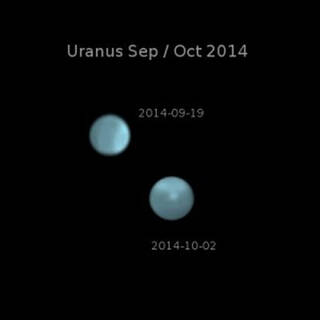
“By combining the information New Horizons collects in space with data from telescopes on Earth, we can supplement and even strengthen our models to uncover the mysteries swirling in the atmospheres of Uranus and Neptune,” said Alan Stern, New Horizons principal investigator from the Southwest Research Institute in Boulder, Colorado. “Even from amateur astronomer telescopes as small as 16 inches, these complementary observations can be extremely important.”
With New Horizons and Hubble focused on the details of the planets’ atmospheres and the transfer of heat from their rocky cores through their gaseous exteriors, observers on Earth can measure the distribution of bright features on Uranus or characterize any unusually bright features on Neptune. They can also track those features much longer than either spacecraft.
Following the campaign, observers can post their images – as well as the details of when they were made and in what filter passbands – on X (formerly Twitter) or Facebook using the hashtag #NHIceGiants. The New Horizons team will see and collect the images and supporting information placed on these platforms using this identifying hashtag.
The Hubble images of Uranus and Neptune will be made publicly available in late September on the Mikulski Archive for Space Telescopes, or MAST, at archive.stsci.edu. The New Horizons team expects to receive the images of Uranus and Neptune from the spacecraft by the end of 2023 and will make them available as well.
The Johns Hopkins Applied Physics Laboratory in Laurel, Maryland, designed, built, and operates the New Horizons spacecraft, and manages the mission for NASA’s Science Mission Directorate. Southwest Research Institute, in San Antonio and Boulder, Colorado, directs the mission via Principal Investigator Alan Stern, and leads the science team, payload operations and encounter science planning. New Horizons is part of the New Frontiers Program managed by NASA’s Marshall Space Flight Center.


























